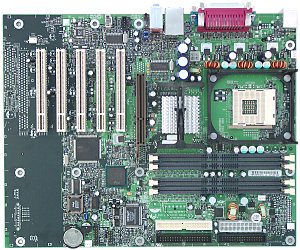The board features an unusual set of chips and
a USB 2.0 controller from NEC; USB 1.1 ports are lacking at all.
We got a pre-production sample with the minimal set of accessories.
Accessories:
- CD with software including:
- drivers;
- user manual in PDF;
- Adobe Acrobat Reader;
- NTI CD-Maker 2000 Standard;
- RealOne;
- DFX for RealOne;
- Macromedia Shockwave 8 Test;
- Norton Internet Security 2002 with Antivirus;
- DirectX 8.0a;
- Intel Active Monitor (for system monitoring).

The layout is almost the same as compared with the previous D850MV (on
the i850), that is why all drawbacks remain here: audio-ins which are located
in front of the PCI slots; the elements are too close to each other because
the PCB of almost the same design is used in the microATX version; when
a video card in installed it's not easy to handle the memory modules. It's
not difficult to reach the only jumper even when the board is already installed.
Its function is shown on the textolite.
The 3-channel switching voltage regulator incorporates 2 capacitors
of 3300 uF and 3 of 2200 uF.
The following controllers are integrated: an audio one based on the
chipset's capabilities and AC'97 codec AD1885 from Analog Devices with
an output for front audio connectors; a network one based on the chipset's
capabilities supporting 10BaseT/100BaseTX; USB 2.0 controller based on
the NEC D720100AGM chip.
Non-unsoldered connectors: 1 PCI slot and 1 CNR, an AUX Power connector
and the one with USB ports on the rear panel (it is used in the board version
without a USB 2.0 controller).
The system monitoring is supported by the SMSC LPC47M142-NC chip. Processor
voltage (+3.3, +5 and +12 V), speed of 2 fans and temperatures of the processor
(a built-in sensor), and the board (a built-in sensor) can be controlled.
There are 2 connectors for adjustable connection of fans and 2 for non-adjustable
connection.
Brief characteristics of the board: memory slots - 4 RDRAM; expansion
slots - AGP/ 5 PCI; I/O ports - 2 COM/ LPT/ 2 PS/2/ 4 USB 2.0; dimensions
- 305õ245 mm.

Adjustment can be carried out with:
| jumpers and switches |
Configuration jumper |
Normal/ Config/ Recovery |
| BIOS based on v6.00 from Phoenix |
Setup of memory timings |
- |
 |
| Setup of memory frequency |
- |
 |
| Setup of AGP bus |
- |
 |
| Setup of PCI bus |
- |
 |
| Changeable scaler of AGP and PCI buses |
- |
 |
| Manual assignment of interrupts |
+ |
 |
| Changeable FSB frequency |
- |
 |
| Changeable CPU multiplier |
- |
 |
| Changeable core voltage |
- |
 |
| Changeable memory voltage |
- |
 |
| Changeable chipset voltage |
- |
 |
| Changeable AGP bus voltage |
- |
 |
We used the latest available version of the BIOS - P07.
The board is conservative: you can't adjust anything; besides, it doesn't
have much functions. I can recommend it for users who don't require much
as far as functionality is concerned and who want to get a highly stable
solution.
Test results:
Write a comment below. No registration needed!


